 |
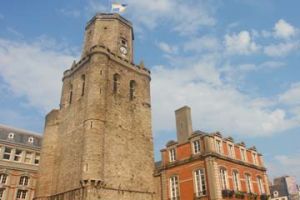
|
 Boulogne/Mer. Belfry © T. Joly Boulogne/Mer. Belfry © T. Joly

|
Boulogne-sur-Mer is much more than just France’s largest fishing port. A charming medieval walled town, an exceptional marine park and beautiful beaches make it a destination well worth a weekend away.
[ Practical ]
Getting there
- By road
250 km from Paris on autoroute A1 till Saint Denis, on N1 and D301 till L’Isle Adam, then on autoroute A16 till Boulogne-sur-Mer.
- By train
Train Intercités from Paris Gare du Nord to Boulogne-sur-Mer or TGV from Paris Gare du Nord to Calais Fréthun then TER to Boulogne-sur-Mer. The journey takes between 2 h 20 and 2 h 45.
- By ferry
LD ferries from Dover to Boulogne-sur-Mer.
Lodging
- Hotels
Hôtel La Matelote
Hôtel Ibis Vieille Ville
Hôtel Alexandra
Hôtel Metropole
Hôtel de Londres
- Bed and breakfast
L’Enclos de l’Eveché
La Volière
Restaurants
La Matelote
Les Terrasses de l’Enclos
Au Pêcheurs d’Etaples
Le Chatillon
L’esprit d’Hélène
Le Doyen
La Haute Ville
Getting around
All sights are within walking distance.
Nausicaa
Open every day from 8.30 am to 6.30 pm, till 7.30 pm in July and August.
Admission : €17,40 / €11,20.
Tel : 0321309999
www.nausicaa.fr
Château – Musée
Open every day except Tuesday from 10 am to 12 h 30 pm and from 2 pm to 5.30 pm.
Admission : €4,50/ €3.
Tel : 0321100222
Information
- Nord – Pas de Calais Tourist Office
www.tourisme-nordpasdecalais.fr
Tel : 0320145757
- Pas de Calais Tourist Office
Tel : 0321103460
www.pas-de-calais.com
- Boulogne-sur-Mer Tourist Office
Tel : 0321108810
www.tourisme-boulognesurmer.com
Like a lighthouse standing in the middle of agricultural fields, the 54 m high Column of the Great Army informs travellers that they are getting close to Boulogne-sur-Mer. From its summit reached by a staircase comprising 253 steps, one discovers the town nested in a natural amphitheatre at the mouth of the Liane River as well as the beaches and the cliffs bordering the sea. On a clear day, it’s even possible to see the English coast and Dover castle.
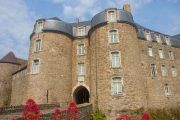
 Boulogne/Mer. Castle © T.Joly Boulogne/Mer. Castle © T.Joly
|
 Castle without keep Castle without keep
Topped by a statue of Napoleon I, this column situated in the village of Wimille commemorates the Emperor aborted attempt to invade England. For this purpose, between 1803 and 1805 he gathered an army of 185,000 soldiers and a fleet of 2,000 boats in this northern French port.
Many centuries earlier, Romans also chose to sail from this area on their successful conquest of England and Julius Cesar may be considered as the founder of Boulogne-sur-Mer.
A 400 m x 300 m quadrangle protected by medieval ramparts with four powerful gates, the old town – or upper town – indeed stands exactly on the site of the fortified camp built in 55 BC on a hill overlooking the port. Besides, remains of the 4th century Roman walls are visible in the subterranean passages of the 13th century castle occupying the Eastern angle of the ramparts. France’s first castle ever built without a keep, still surrounded by moats, it is perfectly well preserved and nowadays houses a rich and eclectic museum.
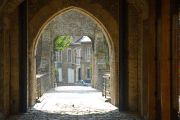
 Boulogne/Mer. Walled town © T.Joly Boulogne/Mer. Walled town © T.Joly
|
 Egyptian antiquities Egyptian antiquities
Its rooms hold 19th century French paintings and sculptures, including works by Corot and Rodin, 17th and 18th centuries porcelains and earthenware, glassworks, medieval works of art, ethnographic collections of Oceanian, African, Inuit and Aleutian art, Greek and Etruscan vases, Roman artefacts found during excavations conducted in the region and many Egyptian antiquities.
Indeed, Boulogne-sur-Mer is the birthplace of Mariette, one of the greatest Egyptologist in history as well as the founder and the first director of Cairo’s museum. A statue just outside the North rampart depicts him on top of a small pyramid.
Miraculously spared bombing during both WWI and WWII, the walled town concentrates most of Boulogne’s historical heritage and is dominated by the vast Notre Dame basilica said to be inspired by Saint Paul of London, Saint Peter of Rome and Saint Louis des Invalides of Paris. No less !!!
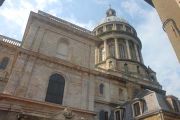
 Boulogne/Mer. Basilica © T.Joly Boulogne/Mer. Basilica © T.Joly
|
 A vast dome A vast dome
Constructed in the 19th century to replace the medieval cathedral destroyed during the Revolution, it is surmounted by a 101 m high dome and is built over France’s second largest crypt. There, you can see remains of the Romanesque cathedral and of a Roman temple as well as several religious works of art including a precious 14th century reliquary created to hold a flask of Holy Blood. It was gift of another famous native of Boulogne, Godefroy de Bouillon, who was the chief leader of the first crusade. But if the basilica attracts many pilgrims since centuries it’s because it holds a statue of the Virgin Mary that was found ashore in the 7th century.
The city oldest monument is the belfry dating from the 12th century. Former keep of the first castle of the Counts of Boulogne, it was integrated in the city hall built during the reign of Louis XV. On the same square you can also see the former 17th century Annunciates convent, now a library, and the Imperial Palace, a 18th century classic building that served as headquarter of the Great Army and where Napoleon stayed briefly on several occasions.

 Boulogne/Mer. Porte des Dunes © T.Joly Boulogne/Mer. Porte des Dunes © T.Joly
|
 General San Martin’s house General San Martin’s house
Crisscrossed by picturesque cobbled streets with well-preserved old stone houses, the upper town is however not only an open-air museum. Thanks to the presence of many bars and little restaurants with their tables and chairs spilling out onto the pavement, there is a warm and authentic atmosphere. They are perfect places to taste the local specialties, seafood and the great beers brewed in the region. The top of the belfry and the walkway atop the ramparts provide great views over this neighborhood as well as over the lower town and the port. To get there, exit through the Porte des Dunes, the principle gate, and take the Grande Rue. One of the main shopping thoroughfares, lined with 18th century, it is a popular destination for South Americans. At N°105 indeed stands the Casa San Martin where the general who liberated Peru, Chile and Argentina from Spanish colonial rules lived from 1848 till his death in 1850. Furnished as it was at that time, it hosts a small exhibition evoking his life.
 Fresh fish Fresh fish
Further downhill you get to the city centre, a bustling mixture of shops, restaurants and cafés, bisected by pedestrian streets and a lively market is held every Wednesday and Saturday mornings on Place Dalton. This cobbled square is dominated by the city’s oldest church devoted to Saint Nicolas, protector of sailors, where starts the Grande Procession in honor of the Virgin that takes place every year in August. Just a stone’s throw away, the Quai Gambetta has been transformed into a charming promenade from where you can enjoy a beautiful view over the port.
It consists of a ferry terminal serving Dover, a marina and France’s largest fishing harbor. There is always some activity on the quayside and when the smaller fishing boats come back, you can see the fishermen sorting their catch that are either loaded straight into vans to be delivered elsewhere, or simply carried across the quayside to be sold from any one of several stalls on the edge of the car park. It can’t be fresher and you will be impressed by the skills of the stallholders, almost exclusively women, as they gut and fillet the different fish varieties.
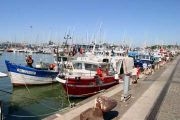
 Boulogne/Mer © Eric Desaunois Boulogne/Mer © Eric Desaunois
|
 Large marine park Large marine park
You can also take a guided tour to visit Capécure, where industrial fishing boats unload their catches and where the fish is auctioned, frozen, salted, smoked and generally processed. And if you want to learn more about the maritime history of Boulogne have a look at the Maison de la Beurière, a former fishermen cottage, now a museum of life in days gone by in the fishing community. Near by, perched on the cliff overlooking the port a calvary built in the style of a hull of a ship is dedicated to the memory of sailors lost at sea. It stands next to the only remnant of Napoleon’s pre – invasion works, the “Poudrière”, a square brick built building with air holes where 120 powder kegs were stored.
A kids’ favourite and a not-to-be-missed place for sea lovers, Nausicaa is one of Europe’s largest marine park with some 40 aquariums and pools holding 34 000 animals of 1 000 species such as penguins, sharks, rays, lagoon fishes, sea lions, jellyfishes,…
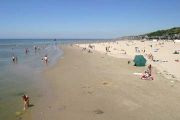
 Boulogne/Mer © Eric Desaunois Boulogne/Mer © Eric Desaunois
|
 Well-known seaside resort Well-known seaside resort
But it’s more than just a marine Noah’s Ark. Also known under the name of “National Sea Centre”, it’s a place that focuses on relationships between Man and sea, increases visitors awareness about sea diversity and dangers threatening the ecosystems and where you discover the marine environment in a playful, educational and scientific way.
If you want to have a more relaxing stay, Boulogne-sur-Mer is also a seaside resort. Since 1820, when the second bathing club in France was constructed there. During the 19th century if was even one of the most popular holiday destinations for wealthy Parisians and it’s easy to understand why. Sandy beaches stretch for miles and miles, the closest one being next door to Nausicaa, and the beautiful Opal Coast also boasts spectacular cliffs at the nearby Cap Gris Nez Cape and Cap Blanc Nez. Two great places to hike.
September 30, 2011
Thierry Joly 

|



